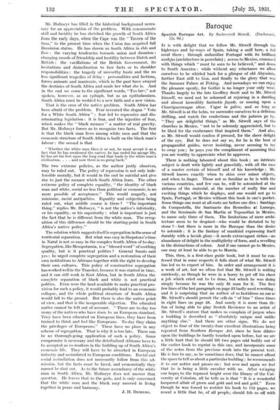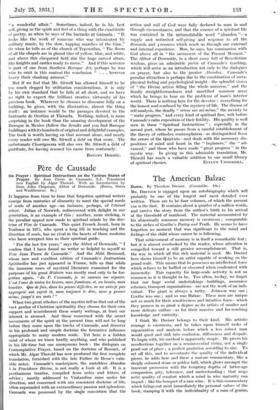Baroque
IT is with delight that we follow Mr. Sitwell through the highways and by-ways of Spain, taking a sniff here, a full meal there ; through unfamiliar Portugal with its brilliant azulejos (architecture in porcelain) ; across to Mexico, crammed with things which " must be seen to be believed," and down to South America : while without any reluctance we allow ourselves to be whirled back for a glimpse of old Abyssinia, further East still to Goa, and finally to the glory that was the Summer Palace at Peking. And nowadays we can enjoy the pleasure openly, for Gothic is no longer your only wear. Thanks largely to the late Geoffrey Scott and to Mr. Sitwell himself, we need not be ashamed at rejoicing in a dazzling and almost incredibly fantastic facade, or musing upon a Churriguerresque altar. Vogue la galere, and so long as Mr. Sitwell is at the helm, we surrender ourselves to a delicious drifting, and watch the confections and the palaces go by. " They are delightful things," as Mr. Sitwell says of the churches in Mexico, " not to be solemnly appreciated, but to be liked for the exuberance that inspired them." And also, as Mr. Sitwell would confess if pressed, for the sheer delight of the eye. But he does not say so, for he is the best of propagandist guides, never insisting, never seeming to try to sway you ; he pays you the compliment of assuming that you are worthy to appreciate what he approves.
There is nothing laboured about this book ; an intricate subject is dealt with lightly and gracefully, with all the ease of a master certain of himself and of his knowledge ; Mr. Sitwell knows exactly when to skim over minor objects, and when to linger. Those not so familiar as he is with the various countries, and few can be, will be astonished at the richness of the material, at the number of really fine and exciting things which he displays, and one would not go to Spain, Portugal, or Mexico without this book in one's pocket. Some things one must at all costs see before one dies ; Santiago da Compostella, the Santuario dos Remedios at Lamego, and the Seminario de San Martin at Tepozotlan in Mexico, to name only three of them. The limitations of mere archi- tecture seem to be despised—who would - be dictated to by stone ?—but there is more in the Baroque than the desire to astonish : it is the fantasy of mankind expressing itself durably with a lavish glory—it needs extravagant riches—an abundance of delight in the multiplicity of form, and a revelling in the distractions of colour. And if one cannot go to Mexico, one may at least be able to go to Murcia.
This, then, is a first-class guide book; but it must be con- fessed that in some respects it falls short of what Mr. Sitwell has led us to expect of him. In order and arrangement it is a work of art, but we often feel that Mr. Sitwell is writing carelessly, as though he were in a hurry to get off his chest a job which cried out to Le done, but which he was doing simply because he was the only fit man for it. The first few lines of the last paragraph on page 23 badly need rewriting ; and it is surprising that an author of so fastidious an ear as Mr. Sitwell's should permit the refrain " of him" three times in eight lines on page 28. And surely it is more than the fun of being able to play Scotch Reviewer to an artist of Mr. Sitwell's stature that makes us complain of jargon when a building is described as " absolutely unique and unlike anything else." And there are other signs. We do not object to four of the twenty-four excellent illustrations being repeated from Southern Baroque Art, since he here dilates upon the buildings he hardly touched upon before, but we are a little hurt that he should lift two pages odd bodily out of the earlier book to reprint in this one, and incorporate some of the notes from the previous work into the present text. He is free to say, as he sometimes does, that he cannot afford the space to tell us about a particular building ; he recommends it to our notice and passes on : but now and again we feel that he is being a little cavalier with us. After ss ranging our hopek to the topmost height over the library of the Uni- versity at Coimbra, all he tells us is that " It is a wonderful lacquered affair of green and gold and red and gold." Even though he was forced to restrict his book to 112 pages; we resent a little that he, of all people, -should fob- us off with " a wonderful affair." Sometimes, indeed, he is his best self, giving us the spirit and feel of a thing with the exactitude of poetry, as when he says of the barracks at Granada ; "It looks like the work of someone who was intoxicated by military music, by the slow, tapping marches of the time." Or when he tells us of the church of Tepozotlan, " The floors of all the chapels are in glazed tiles of yellow, blue, and white, and above this chequered field rise the huge carved altars, like knights and castles ready to move." And if this sentence is part of one from Southern Baroque Art, perhaps he was wise to omit in this context the conclusion " . . . however heavy their clanking armour."
But if we feel that Mr. Sitwell has allowed himself to be too much clogged by utilitarian considerations, it is only by his own standard that he falls at all short, and we have no right to expect the brilliant creative virtuosity of his previous book. Wherever he chooses to discourse fully on a building, he gives, with the illustration, almost the thing itself : an instance would be the passages devoted to the Santuario de Ocotlan at Tlaxacla. Nothing, indeed, is more surprising in the book than the amazing development of the Baroque in Mexico (follow the Jesuits and you find Baroque buildings) with its hundreds of original and delightful examples. The book is worth having on that account alone, and nearly every reader will owe Mr. Sitwell a debt on that score. The unfortunate Churriguerra will also owe Mr. Sitwell a debt of gratitude, for having rescued his name from contumely.
BONAMY DOBREE.











































 Previous page
Previous page